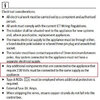I am becoming increasingly confused and frustrated by this ‘RCD Types’ business.
Most of what I can find to read about the different types says much the same as 531.3.3 of BS7671, majoring on what sort of residual currents will trip them but saying nothing directly about the issue that so often gets discussed here, namely the potential of DC components of current to impair the functioning (tripping) of the device if a AC (or pulsating DC) residual current arises.
However, in relation to Types A, F and B, 531.3.3 includes:
Firstly, it is not totally clear (at least, not to me) whether the “superimposed smooth direct current” (in all of those cases) is a “residual” current or a balanced (L& N) one. Since they have not included the word “residual” in relation to it, I’m inclined to think that they probably do not mean ‘residual current’, but I can’t be certain.
Next, those three notes only refer to tripping being ‘achieved’ with “residual pulsating direct currents”, and hence say nothing at all about tripping in relation to any other type of residual current.
In particular we are told nothing about how tripping in response to AC residual currents (which has been the basis of nearly all of our discussions, and also flameport’s experiment/ demonstration) for any of the types of RCD (including Type AC) is affected by superimposed DC currents (be they ‘residual’ or not).
Even in relation to tripping as a result of “residual pulsating direct currents”, we are only told that this is ‘achieved’ if that residual current is superimposed on a smooth DC current “up to” 6mA for Type A, 10 mA for Type F and 12 mA for (30mA) Type B. Does that mean that these devices will not ‘achieve’ a trip due to “residual pulsating direct currents” if the “superimposed smooth DC current” (be it ‘residual’ or not!!) is more than those (very small) figures? If so, are they actually fit for any purpose? ... or am I misunderstanding what they are saying?
So, as above, I find this all about as clear as mud, and therefore continue to be frustrated and confused. Can anyone help me understand - or, as I have asked many times, point me towards some genuinely useful reading material?
Kind Regards, John
Most of what I can find to read about the different types says much the same as 531.3.3 of BS7671, majoring on what sort of residual currents will trip them but saying nothing directly about the issue that so often gets discussed here, namely the potential of DC components of current to impair the functioning (tripping) of the device if a AC (or pulsating DC) residual current arises.
However, in relation to Types A, F and B, 531.3.3 includes:
531.3.3 of BS7671:2018 said:NOTE 1: For RCD Type A, tripping is achieved for residual pulsating direct currents superimposed on a smooth direct current up to 6 mA.
NOTE 2: For RCD Type F, tripping is achieved for residual pulsating direct currents superimposed on a smooth direct current up to 10 mA.
NOTE 3: For RCD Type B, tripping is achieved for residual pulsating direct currents superimposed on a smooth direct current up to 0.4 times the rated residual current (IΔn) or 10 mA, whichever is the highest value.
Firstly, it is not totally clear (at least, not to me) whether the “superimposed smooth direct current” (in all of those cases) is a “residual” current or a balanced (L& N) one. Since they have not included the word “residual” in relation to it, I’m inclined to think that they probably do not mean ‘residual current’, but I can’t be certain.
Next, those three notes only refer to tripping being ‘achieved’ with “residual pulsating direct currents”, and hence say nothing at all about tripping in relation to any other type of residual current.
In particular we are told nothing about how tripping in response to AC residual currents (which has been the basis of nearly all of our discussions, and also flameport’s experiment/ demonstration) for any of the types of RCD (including Type AC) is affected by superimposed DC currents (be they ‘residual’ or not).
Even in relation to tripping as a result of “residual pulsating direct currents”, we are only told that this is ‘achieved’ if that residual current is superimposed on a smooth DC current “up to” 6mA for Type A, 10 mA for Type F and 12 mA for (30mA) Type B. Does that mean that these devices will not ‘achieve’ a trip due to “residual pulsating direct currents” if the “superimposed smooth DC current” (be it ‘residual’ or not!!) is more than those (very small) figures? If so, are they actually fit for any purpose? ... or am I misunderstanding what they are saying?
So, as above, I find this all about as clear as mud, and therefore continue to be frustrated and confused. Can anyone help me understand - or, as I have asked many times, point me towards some genuinely useful reading material?
Kind Regards, John




